Africa Fashion – review of the V & A exhibition
October 2, 2022Africa Fashion sets out to celebrate the creativity and style of Africa and its diaspora. It’s not an educational history of fashion in the continent and it’s not exhaustive. It is political, it’s about Blackness, and personal histories as well as spotlighting great individual designers from the 1960s onwards.
In the 1950s, Africa began to decolonise. Seventeen African countries gained independence in 1960. In 1966, a World Festival of Black Arts was announced. African music, art, dance and theatre were celebrated in a programme of talks and performances. Duke Ellington and Josephine Baker attended amongst thousands of African and African Diaspora creatives and art lovers. It was intended to place Africa on the map as a centre of intelligence and culture, and dispel racist notions of the continent as a “backwards” or, worse, “savage” place.
African Fabrics – Dutch Wax Cloth
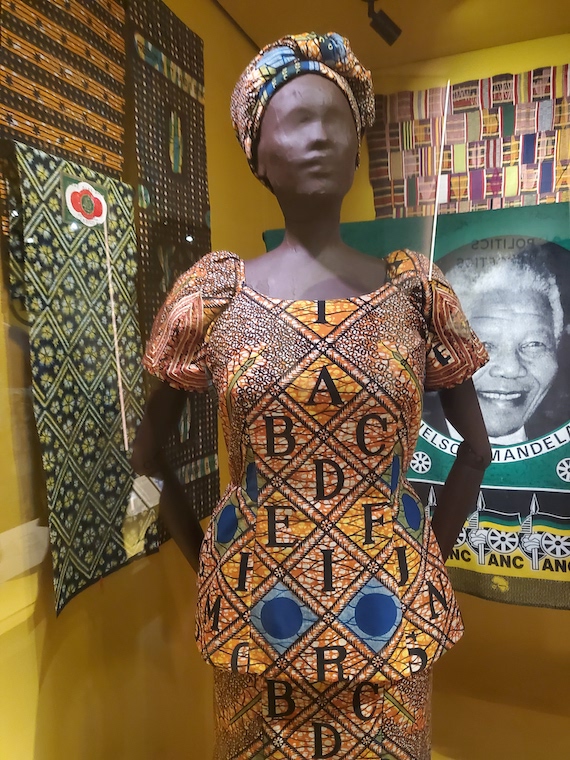
Some examples of Dutch Wax Cloth. Image Genevieve Jones from the Africa Fashion exhibition at the V&A.
Dutch wax cloth, originates, as its name suggests, in the Netherlands. But its successful export to to Africa has left this distinctively bold, beautiful and witty cotton fabric as indelibly connected to African clothes. The designs were originally formed as an imitation of the wax resist batik technique, which has a certain flowing line and crackled effect. But these were mass-manufactured instead, by a Dutch company set up in 1846. The designs are symbolic and can be read – a print of ABC splashed across a dress means the wearer is proud of her learning. A print of telephones? Perhaps the person flaunting it just got hooked up to the exchange. Many prints are more wild and wonderful, and I don’t know if they likewise hold meaning, or the designers just felt free to use very unusual motifs.
After decolonisation, African companies were able to set up their own fabric factories to produce similar themselves, of which they were very proud. Governments encouraged the wearing of locally made fabric, instead of fashions based on imports. In some case they banned imports altogether.
Indigo Dyed Yoruba Fabric
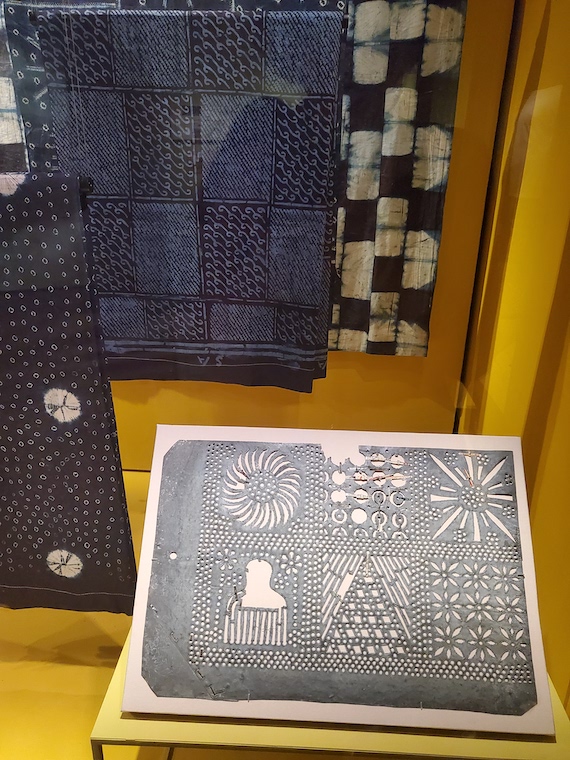
Àdìre cloth and stencil. Image Genevieve Jones from the Africa Fashion exhibition at the V&A.
One distinctive fabric had traditionally been produced by the Yoruba. It is an indigo dyed cotton called àdìre (literally tie dye) which uses tying or starch paste resist and dip-dying to produce patterns. They are universally deep blue.
Money Is Blood
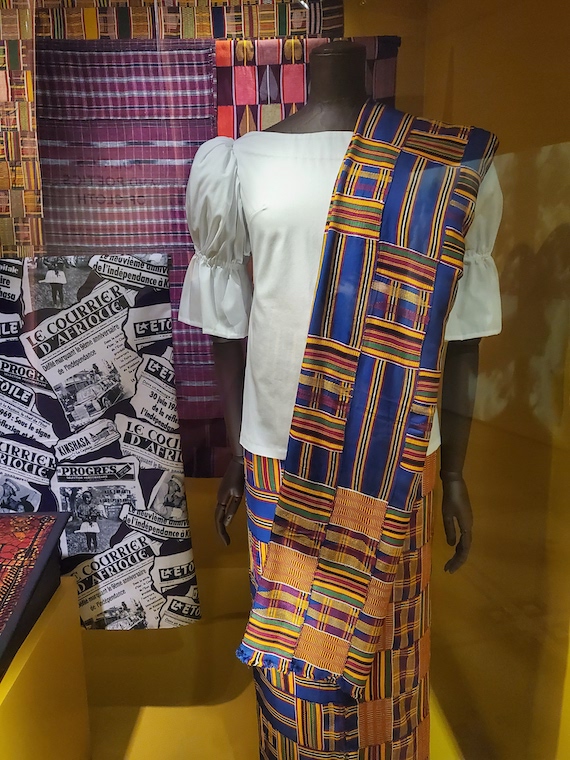
Examples of Kente cloth. Image Genevieve Jones from the Africa Fashion exhibition at the V&A.
Another fabric is narrow strip woven cloth called Kente cloth. The strips of this handwoven cloth are highly expensive and highly prized, and can be sewn together to make larger garments. Each piece is traditionally named by the maker. They are bought for very special occasions, and treasured. The name (and therefore identity) of each piece is carefully considered – one woman bought a piece called “Money is Blood”, to celebrate the fact that she was working and making her own money. It was to commemorate the birth of her first daughter.
African Fashion Designers
From fabrics, we move into a series of showcases of five individual designers.
These designers are all notable in that they mix elements of traditional African design – usually fabric, sometimes silhouette too – with Western design. It’s hard to know if this was a trend in Africa or if the curator just likes this idea. To give a taste, three of these are:
Africa Fashion – Shade Thomas-Fahm
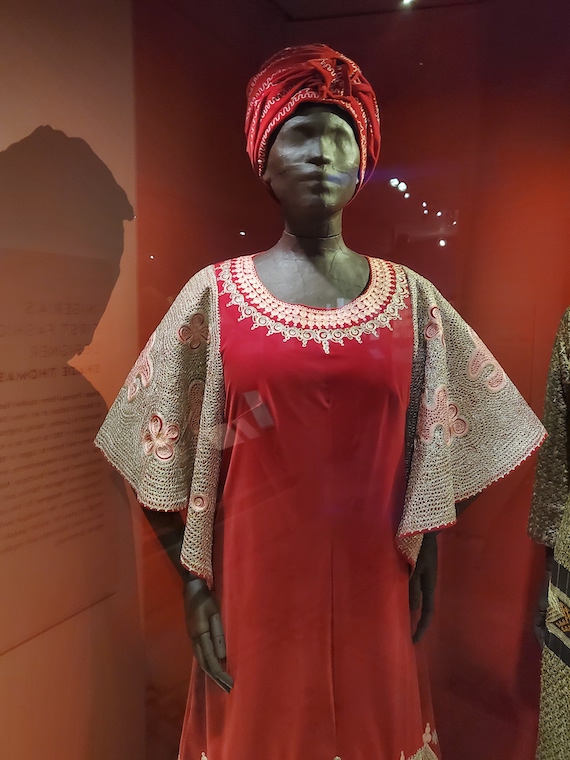
Work by Shade Thomas-Fahm. Image Genevieve Jones from the Africa Fashion exhibition at the V&A.
Shade Thomas-Fahm moved to London to be a nurse and ended up studying fashion at St Martins. When she moved back to Lagos, Nigeria, she became a hit fashion designer. Her work is all about traditional fabrics and shapes made sleek and unique for the modern working woman. One piece, in raspberry velvet, stands out. It was made for Lalage Brown, a professor at Ibadan University in Nigeria to receive her OBE from the Queen. Brown certainly feared the chill of the palace, as the gown has the typical silhouette of the designer, and her signature gold braid, but is made in sensible heavy fabric as opposed to the light and floaty ones usually favoured.
Naima Bennis
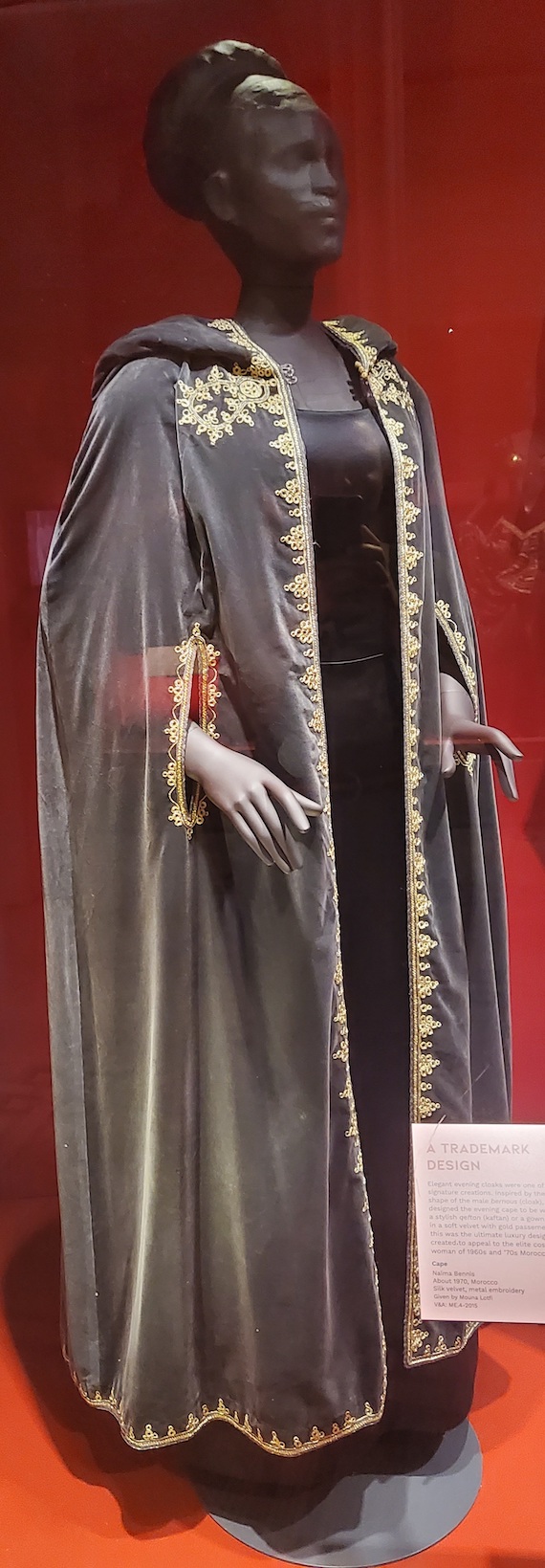
Image Genevieve Jones from the Africa Fashion exhibition at the V&A.
Naima Bennis was a Moroccan designer whose work came to the fore in the 60s and 70s. Her work takes the traditional shapes of kaftans and other clothes of the region and considerably glams them up. A beautiful hooded dove-grey velvet cloak with gold braiding is very covetable. It is based on Berber and Algerian men’s traditional all enveloping burnous cloaks, but this version is transformed into an elegant (and practical) evening coverup.
Africa Fashion – Chris Seydou
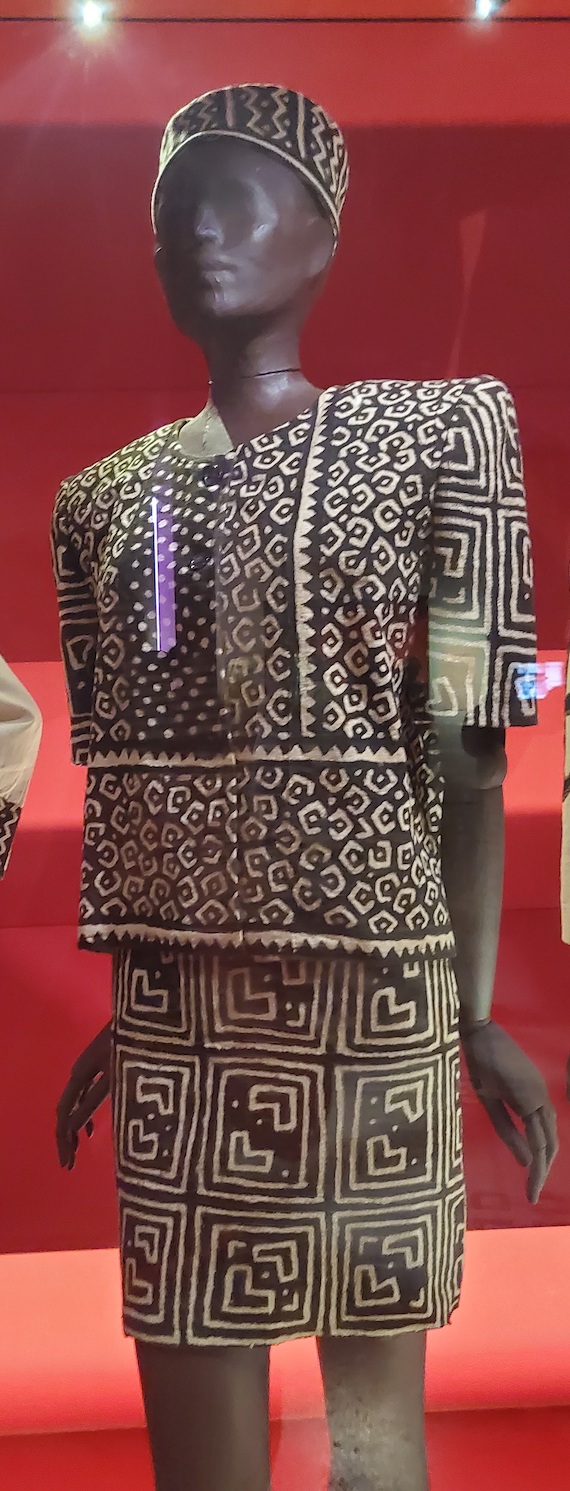
Image Genevieve Jones from the Africa Fashion exhibition at the V&A.
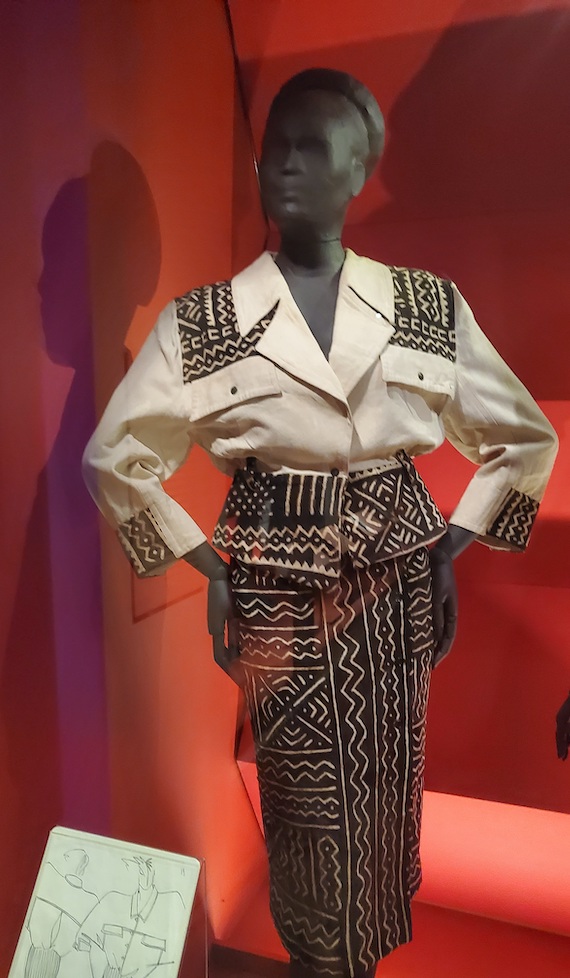
Image Genevieve Jones from the Africa Fashion exhibition at the V&A.
Chris Seydou was an African-born designer who spent many years in Paris from the early 1970s. He worked for French fashion houses as well as his own label. His most striking work is just so 90s. It looks like many Paris catwalks of the time, in particular designers who borrowed elements of African culture themselves, such as Jean-Paul Gaultier.
It also recalls outfits worn by Black Americans like the character Hilary Banks (played by Karyn Parsons) in The Fresh Prince of Bel-Air. She was extremely fashion conscious and these outfits, with a tight miniskirt, boxy-shouldered peplum jacket, and little pillbox hat, all in a bold traditional fabric, look very close to what the costume designers envisaged for her. The rap duo Salt’n’Pepa likewise also wore those hats in the late 80s. There is no doubt that the headwear and fabric in those performers cases were a tribute to their Black roots.
Stylish Memories of Africa fashion
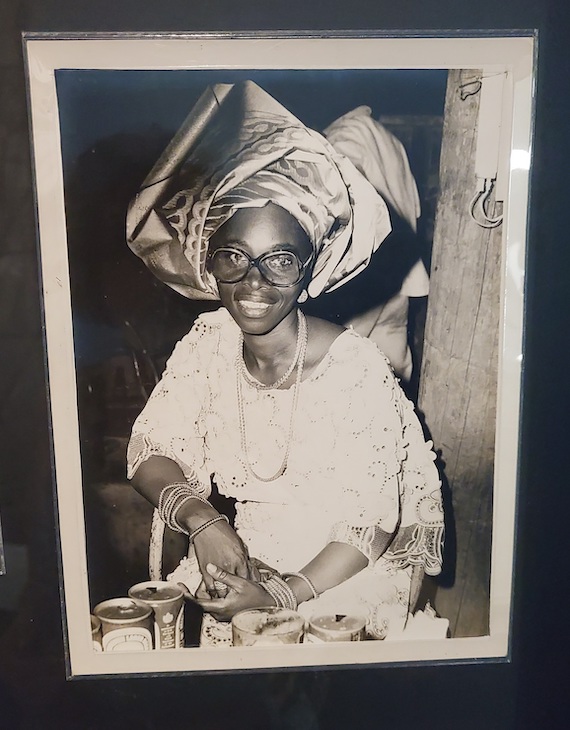
Image Genevieve Jones from the Africa Fashion exhibition at the V&A.
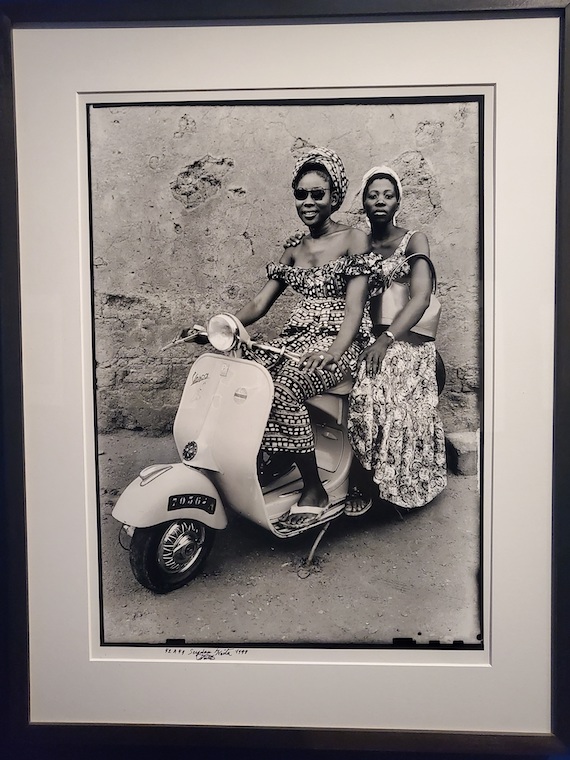
Image Genevieve Jones from the Africa Fashion exhibition at the V&A.
The V&A did a callout for people’s memories and family photographs regarding their African heritage. Alongside photos from professional studios, this has resulted in some especially beautiful, evocative photographs showing street style as it was really worn.
Contemporary Africa Fashion
Upstairs are the contemporary designers. The exhibition shows how vibrant Africa fashion is, today and in the past, and how stylish its people have always been.
Africa Fashion is on at the V and A Museum until 16th April 2023.


